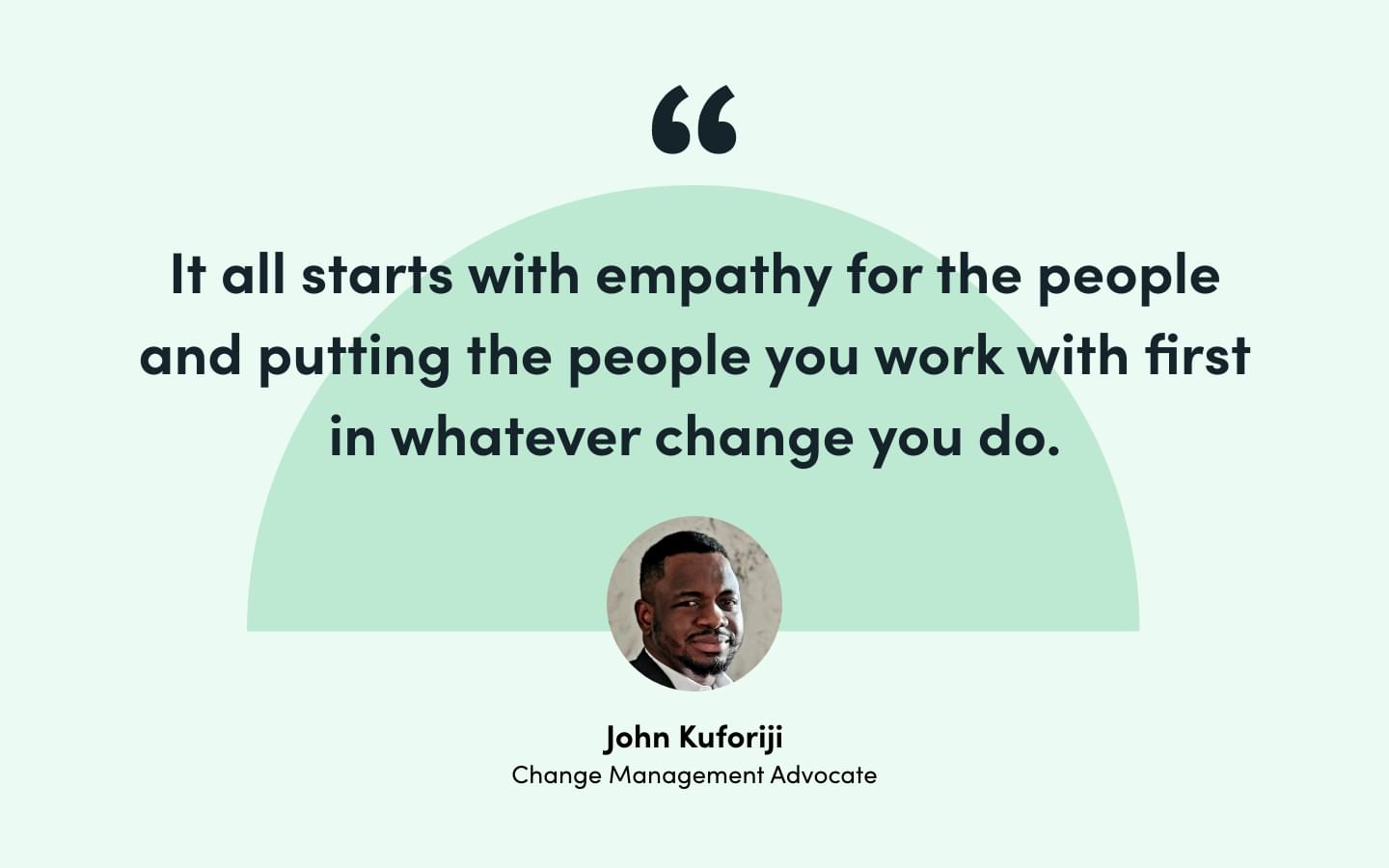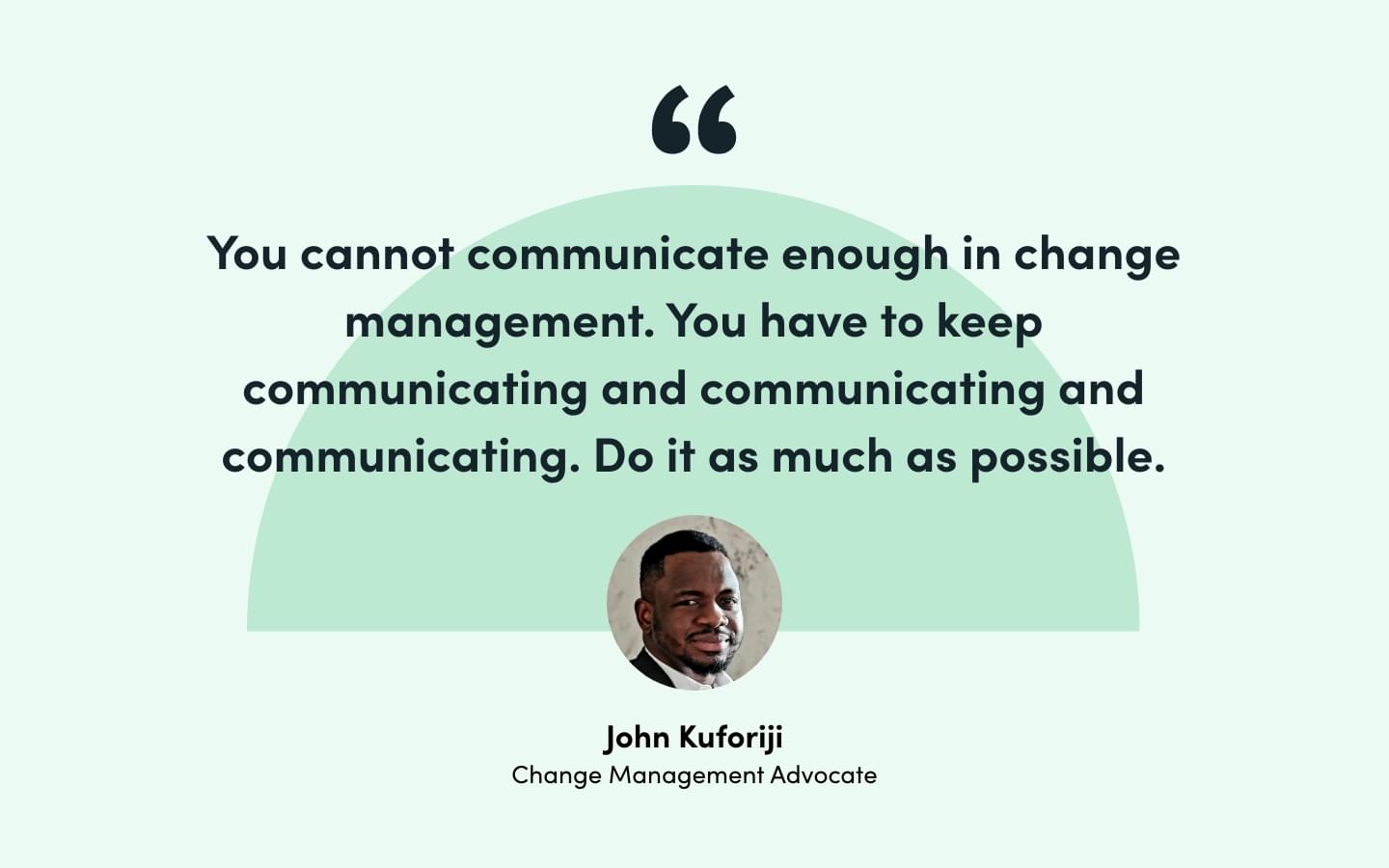“Change is the only constant in life.”
The quote above is attributed to Heraclitus, a Greek philosopher who lived around 450 BCE. Another version of this quote is panta rhei, which translates to “life is flux.” Heraclitus was adamant about the idea that change is always happening, all around us—there’s no escaping it.
It’s been thousands of years since Heraclitus brought these ideas to the world. Yet many still find change to be incredibly difficult to go through, especially within an organization.
Are we destined to struggle with change? Does change always have to be so hard?
John Kuforiji doesn’t think so. The change management expert recently joined us on our Practically Genius podcast to discuss how to build a culture that embraces change. Below, we’ve featured some of his best advice on how to make change easier at your organization.

Listen Now: If you want all his best advice on creating a culture that embraces change, listen to his Genius Spotlight episode Change Management Is More about People than Process now!
1. Find Internal Change Champions
Implementing a change, especially within a larger organization, can be a huge undertaking. When there are several departments involved and multiple systems or processes changing, a lot of questions can arise.
A single person can’t handle all these questions and concerns. That’s why John recommends creating a group of change champions. These champions act as leaders within different departments, roles, and job functions to ensure people in all areas of the business feel heard, seen, and understood throughout the adoption of the change.
“These change champions were able to go to all these other places to talk about the change and be the first level of support,” John said. “So when we deployed, if people had questions, the change champions were right there to calm nerves.”
Consider this group to be an extra support system for workers in your organization as the change is rolled out. But how do you find these internal change champions? Try one of these optionsTry:
- Get recommendations from managers
- Look for early adopters of technology
- Identify people who consistently provide feedback
- Offer the opportunity to highly engaged employees
- Sending out communications asking for help
Change champions make it easier for employees to seek help or bring up concerns when going through a large-scale change. They play an incredibly important role if your organization is working with an outside consultant or change management firm. “I find it easier to ask my colleague a question about something, rather than go to a consultant that just came into the organization, because the relationship is there,” John shared.
He went on to point out that these change champions must be front-line workers, versus managers or executives. Why? “People tend to listen more to their peers teaching them things than when it's coming from the manager,” he said. “Because it's at a horizontal level, it's not top-down, it's a peer-to-peer relationship. There is that rapport; there is a relationship.”

2. Always Approach with Empathy
Change can be difficult for anyone, and for many different reasons. It can be hard for people to open up about where their resistance to change comes from—it could be a fear of being automated out of a job or being unable to adapt to a new process or technology.
No matter where the resistance to change originates, approaching every step of a change with empathy and understanding is crucial to helping people overcome fears and challenges. John stated that achieving this requires “putting the people first before the processes.”

“It all starts with empathy for the people and putting the people you work with first in whatever change you do,” John explained. “When implementing this change, we don't want to just dump it in your laps. We want to know what are your concerns with it? We want to help you to adapt. We want to help you to be able to use this. We want to help you to overcome these concerns or those barriers you think you might have.”
According to John, making people feel valued can break down a lot of barriers. He offers a few great suggestions in the episode on how to add empathy into the change management process. Some of his tips include:
Use multiple forms of communication. People all learn differently. Some prefer watching videos, while others would much rather read text. Use a wide combination of communication tactics to ensure all employees have access to the type of content that fits their learning style best.
Make executives visible and accessible. John mentions that having a strong executive presence greatly increases adoption of change. When employees not only see an executive leader involved, but have access to them to ask questions and raise concerns, it builds trust and transparency throughout the process.
Bring end users into the change process from the beginning. Nothing sabotages a change faster than not bringing in the end users from the start. When not involved, consulted, and engaged, it’s highly likely the change getting implemented will not fully address the needs of this group. This can alienate end users and increase their resistance to future changes.
The best of intentions can fail if empathy isn’t used and people are not put first when a change is being considered. “When you put the people into perspective, you put the people in focus, you're making sure whatever solution you're implementing is tuned to what the people will use,” John shared. “You can implement the most fantastic tool and people will end up not using it. It could be built with the best intentions, but at the end of the day, it just doesn't fit into the needs of users.”
Read Next: 5 Ways to Create a Company Culture Focused on Personal Growth
3. Communicate Often and Openly
Communication is absolutely key to successful change management. In John’s experience, a lack of communication is the most common issue he sees derailing organizations when they’re trying to implement change.
“You cannot communicate enough in change management,” John said. “You have to keep communicating and communicating and communicating. Do it as much as possible.”

But it’s not enough to simply communicate. He pointed out that it’s equally as important to be strategic with your messaging. This includes sharing information as early as possible, with all who are involved, and ensuring those communications are accessible. Also, know that you will need to repeat messages for them to stick.
All this communicating will provide employees with a sense of transparency, openness, and even comfort. But do ensure there’s always a way for employees to provide feedback, address concerns, and get extra details as needed. Communications during change should be a two-way street.
As you begin to bake more communication into your change management strategy, you’ll see it begin to transform people’s mindsets around change. “You're building awareness as you go, desire, training materials, and culture. It's something that if you do constantly, people's mindsets get accustomed to the idea that things change,” John shared. “They become very flexible and their adaptability to change increases.”
Start Making Change Easier
Organizations don’t have to struggle through change. With some smart strategies and clear intentions, you can easily guide employees through any type of change. If you communicate often, use empathy throughout the process, and identify a team to help answer questions and concerns, you’ll start to see your organization adapt to change easier as time goes by.
Discover more tips on how to make change easier at your organization by listening to John’s full Practically Genius podcast episode Change Management Is More about People than Process now!












